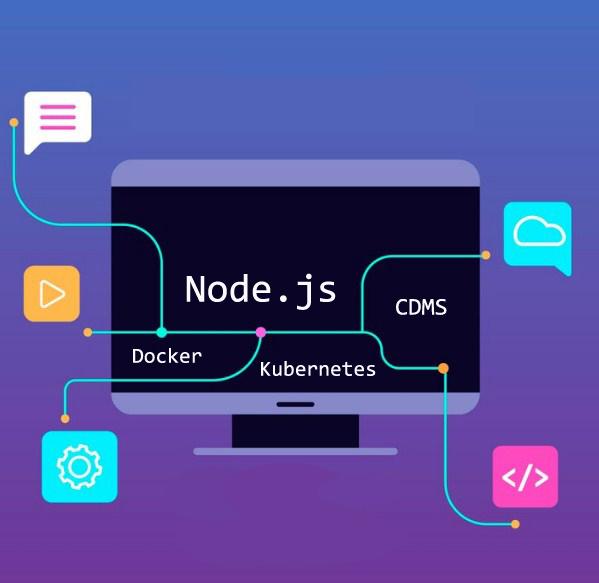Deploying Node.js applications is a critical step in the software development lifecycle. It involves making your application available to users in a production environment. In this blog post, let us explore different tools and techniques for deploying Node.js applications, including Docker, Kubernetes, and CDMS (Continuous Deployment and Continuous Integration). We’ll discuss what each tool offers and how to use them effectively.
Introduction to Node.js Deployment:
Before diving into specific tools, let’s comprehend the basics of Node.js deployment. Deploying a Node.js application involves the following steps:
Constructing The Application: This step will involve compiling and bundling your Node.js code into a deployable package. It may also include installing dependencies and running any necessary build scripts.
Configuring The Environment: You need to set up the runtime environment for your Node.js application. This includes specifying environment variables, configuring database connections, and any other necessary configurations.
Deploying The Application: Once the application is built and the environment is configured, you need to deploy the application to a server or a cloud platform. This step will involve transferring the application files, setting up the necessary infrastructure, and starting the application.
Now, let’s explore the tools that can simplify and streamline the Nodejs web deployment process.
Docker for Node.js Deployment:
Docker is a renowned containerization platform that will permit you to package your application and its dependencies into a lightweight, portable container. Here’s how you can employ Docker for Node.js deployment:
Dockerizing Your Node.Js Application: Construct a Dockerfile that specifies the base image, copies your application code, installs dependencies, and defines the startup command. This Dockerfile will become a blueprint for constructing the Docker image.
Constructing The Docker Image: Use the Docker CLI to build the Docker image based on the Docker file. This process constructs a self-contained image that includes your Node.js application and its dependencies.
Running The Docker Container: Once the Docker image is built, you can run it as a container on any machine that has Docker installed. Docker containers provide isolation and portability, making it easy to deploy your Node.js application across different environments.
Docker simplifies the deployment process by ensuring consistency between development and production environments. It also allows for easy scaling and versioning of your application.
Kubernetes for Node.Js Deployment:
Kubernetes is nothing but an open-source container orchestration platform that regulates the scaling, deployment, and management of containerized applications. Here’s how you can employ Kubernetes for Node.js deployment:
Creating A Kubernetes Cluster: Set up a Kubernetes cluster using a cloud provider or on-premises infrastructure. The collection consists of multiple nodes that run your containers.
Defining Kubernetes Resources: Create Kubernetes resource files, such as Deployment and Service files, to define how your Node.js application should be deployed and exposed. These files specify the desired state of your application and its dependencies.
Deploying The Application To Kubernetes: Use the Kubernetes CLI or a deployment tool like Helm to deploy your Node.js application to the Kubernetes cluster. Kubernetes takes care of scheduling the containers, managing their lifecycle, and ensuring high availability.
Kubernetes provides advanced features like automatic scaling, rolling updates, and service discovery, making it suitable for deploying complex Node.js applications in production environments.
Continuous Deployment and Continuous Integration for Node.js Deployment:
CDMS tools automate the process of building, testing, and deploying your Node.js applications. Here’s how you can employ CDMS for Node.js deployment:
Setting up A CDMS Pipeline: Configure a CDMS pipeline that defines the stages of your deployment process, such as constructing, testing, and deploying. CDMS tools like Jenkins, CircleCI, and GitLab CI/CD provide intuitive interfaces for creating and managing pipelines.
Integrating With Version Control: Connect your CDMS tool to your version control system to trigger the deployment pipeline whenever changes are pushed to the repository. It will ensure that your application is automatically built and deployed whenever new code is committed.
Defining Deployment Stages: Define the stages of your deployment pipeline, such as constructing the application, running tests, and deploying to production or staging environments. Each stage can be configured to run specific commands or scripts.
CDMS tools provide visibility into the deployment process, enable collaboration among team members, and ensure that your Node.js applications are continuously deployed with minimal manual intervention.
Considerations for Node.js Deployment:
While Docker, Kubernetes, and CDMS tools offer significant perks for Node.js deployment, there are some considerations to keep in mind. Firstly, these tools have a learning curve and require some initial setup and configuration. It’s mandatory to allocate time for learning and familiarizing yourself with the tools to ensure smooth adoption.
Additionally, deploying Node.js applications using these tools may require additional resources and infrastructure. Docker containers and Kubernetes clusters consume system resources, and CDMS tools may require dedicated servers or cloud resources. It’s essential to plan and allocate resources accordingly to ensure optimal performance and scalability.
Lastly, security is a crucial aspect of Node.js deployment. When using Docker, it’s essential to ensure that the container images are secure and free from vulnerabilities.
Kubernetes deployments should be appropriately configured to prevent unauthorized access or data breaches. CDMS pipelines should also incorporate security checks and tests to detect potential vulnerabilities in the codebase.
Conclusion:
Deploying Node.js applications using tools like Docker, Kubernetes, and CDMS brings numerous benefits to the development and deployment process. Docker provides consistency, scalability, and efficient resource utilization.
Kubernetes automates container orchestration, enabling seamless scaling, rolling updates, and load balancing. CDMS tools automate the deployment pipeline, ensuring continuous integration and efficient collaboration.
By leveraging these tools effectively, you can streamline the deployment process, improve code quality, and enhance the overall efficiency of your Node.js applications. However, it’s important to consider the learning curve, resource requirements, and security aspects when adopting these tools.
With careful planning and implementation, you can achieve smooth and reliable deployment of your Node.js applications, empowering you to deliver high-quality software to your users.



